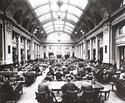 Only two of the early libraries, Stirling's (1791) and the Glasgow Public Library (1804) continued to supply subscription library services into the 19th century, but in 1877 library service in the city entered a new era with the opening of The Mitchell Library - once described grandiloquently as "the British Museum Library of the West of Scotland". It was opened as Glasgow's first free public reference library, totally financed by a £70,000 bequest from Stephen Mitchell, a Glasgow tobacco manufacturer. It soon achieved fame as the largest library of its kind in Europe.
Only two of the early libraries, Stirling's (1791) and the Glasgow Public Library (1804) continued to supply subscription library services into the 19th century, but in 1877 library service in the city entered a new era with the opening of The Mitchell Library - once described grandiloquently as "the British Museum Library of the West of Scotland". It was opened as Glasgow's first free public reference library, totally financed by a £70,000 bequest from Stephen Mitchell, a Glasgow tobacco manufacturer. It soon achieved fame as the largest library of its kind in Europe.
 In 1899 a Corporation Tramways and General Purposes Act was passed with an unexpected addendum to permit the Corporation to levy a one penny (1d.) rate to set up a free public lending library service, and in 1901 Andrew Carnegie, iron master and philanthropist paid for twelve of the city's new public libraries. The long-running Stirling's Library finally came to rest, amalgamating with the Glasgow Public Library and becoming Glasgow Corporation's central public library in 1912.
In 1899 a Corporation Tramways and General Purposes Act was passed with an unexpected addendum to permit the Corporation to levy a one penny (1d.) rate to set up a free public lending library service, and in 1901 Andrew Carnegie, iron master and philanthropist paid for twelve of the city's new public libraries. The long-running Stirling's Library finally came to rest, amalgamating with the Glasgow Public Library and becoming Glasgow Corporation's central public library in 1912.
 Mainly with the profits from Glasgow's 1888 International Exhibition, sufficient funds were available to build the magnificent Kelvingrove Art Gallery & Museum (opened 1901). The museum occupies the ground floor while the upper galleries contain an international collection of Impressionist paintings along with significant Dutch and Italian Renaissance paintings.
Mainly with the profits from Glasgow's 1888 International Exhibition, sufficient funds were available to build the magnificent Kelvingrove Art Gallery & Museum (opened 1901). The museum occupies the ground floor while the upper galleries contain an international collection of Impressionist paintings along with significant Dutch and Italian Renaissance paintings.
 The People's Palace was opened on Glasgow Green in 1898. Originally designed to supply a cultural centre for the working classes of the East End, it soon became, and remains, the city's own museum displaying artefacts, paintings and photographs of Glasgow life.
The People's Palace was opened on Glasgow Green in 1898. Originally designed to supply a cultural centre for the working classes of the East End, it soon became, and remains, the city's own museum displaying artefacts, paintings and photographs of Glasgow life.